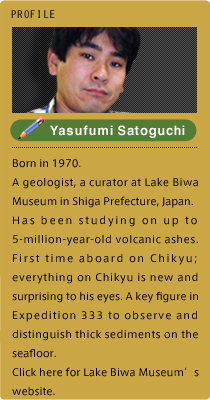

“The world 4,000 m beneath the surface of the sea and underneath”2010.12.27
Have you ever seen the world 4,000 m beneath the surface of the sea?
I suppose there are some people who have seen the deep sea expedition images on TV. I had never seen the actual seafloor, but I am right now looking at something that came from below the seafloor. This “something” is a part of sediments formed deep underneath the seafloor.
Chikyu is a deep sea drilling vessel, and the good thing about drilling expedition is that we can actually do “hands-on” researches on those normally unseen sub-seafloor environments and learn their composition structures. This kind of analysis can rarely be done so easily except on research vessels like Chikyu. The Expedition 333 is one of those exclusive research cruise and we are currently stopping the ship at offshore of Kii Peninsula and drilling deeper than 4,000 m and collecting sections of strata and rocks.
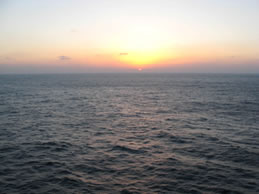
Sunset of the Earth. Surrounded by horizon, 360 degrees.
Imagine the depth of 4,000 m. Hard to imagine? Mt. Fuji is about 3,700 m, so if you think of this depth upside down, you can even reach higher than Mt. Fuji. It is THAT deep. We use a drill that is longer than the height of the Mt. Fuji. It is a great mission already to lower such a drill deep into the sea, but it does not only reach the seafloor, but it drills below the seafloor after arriving down there! Yes, it “drills” underneath the seafloor!!! (I had to repeat it, because it really does impress me.) Isn’t it great!? But maybe it is too hard to imagine…
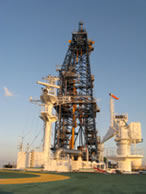
Derrick at sunset. This huge derrick is essential for dropping boring machinery to 4,000 m below the seafloor.
I would like to show you how the actual core looks like, but there is a regulation that says the actual core images must not be shown until the research results are officially released. So I can not show it to you at the moment, but when it comes out, I am sure you will enjoy looking at them. At least, I would be very happy if you could feel this excitement of us scientists onboard, holding up the sediments that came from 4,000 m below the seafloor. The recovered cores are to be taken by scientists onboard, and used for their different purposes of research. The cores are very valuable, so the research purposes are carefully examining. This means, you can not say you want some cores because you want to sow them in your garden to see how they would grow! What about my purpose of research? Well, like I explained last time, I was fortunately approved to get onboard and take samples for my research purpose. Each scientist requires necessary amount of core for their analyses. The amount of the core recovered from boring is limited, so the distribution is carefully considered and decided by the committee. The work going on during the cruise is basically collecting data including core description, and sampling and distributing the core retrieved in turn.
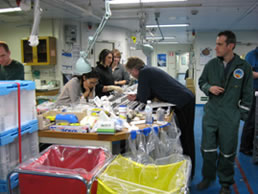
Sampling scene.
We work in turn. On the right is Dr. Pierre Henry, the Co-Chief Scientist.
He checks around to know everything that is going on during the entire cruise.
(Not just being too strict; it is his job to keep his eye on every single detail of the expedition work...)
It may be imagined that scientists are working very seriously. But in reality, we are working quite happily. This may be because we are in the state of cruise-exhaustion “high”... Since we are dealing with such valuable and precious cores, it is our duty to write proper research report and publish it as a paper. We have reports to give in during the cruise, and discussions and conclusions are being made onboard along with the on-going research works.
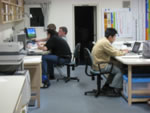
Writing research report. We work in groups for core description and analyses to produce a report. After we get off the ship, these papers are polished into scientific papers to be published.
Yasufumi Satoguchi














